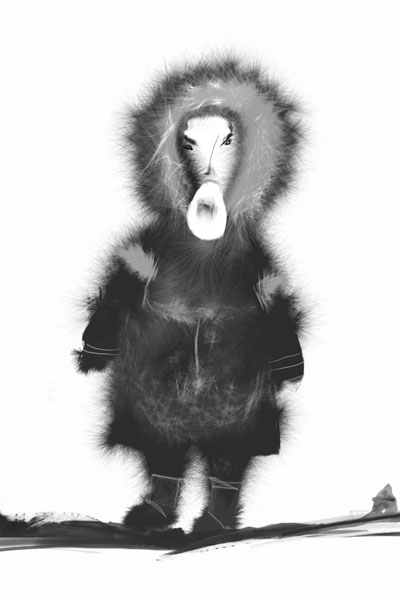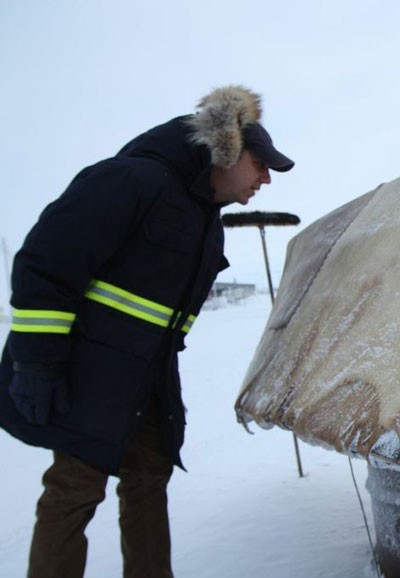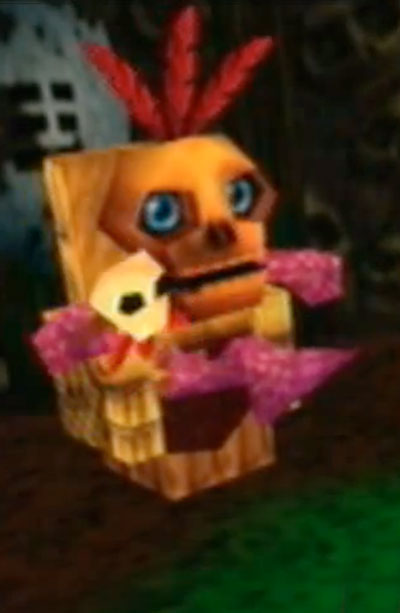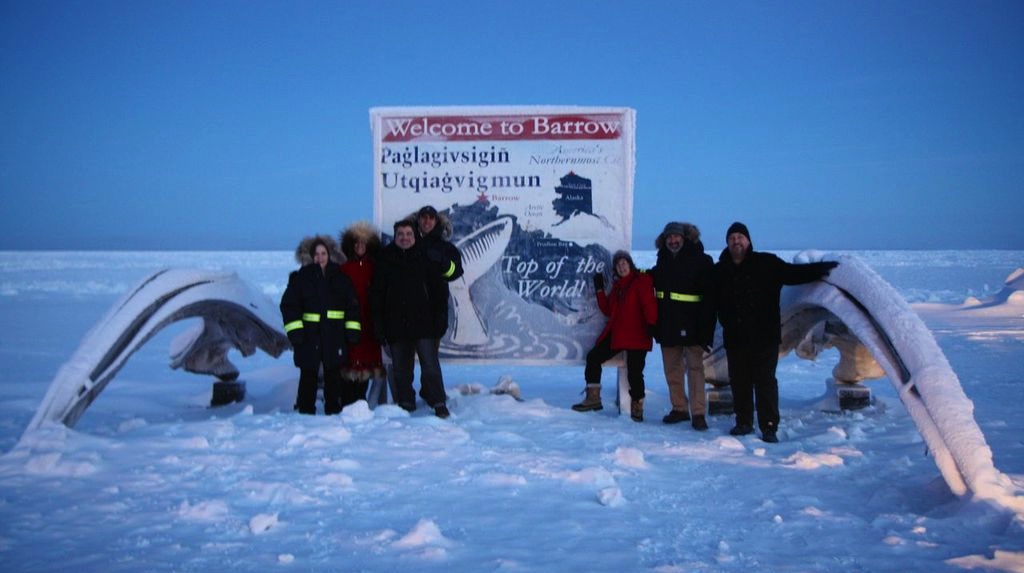The first Native American games company
How one woman, tired of seeing derogatory Native American cliches, decided to make games about her people.
"The women are always so tiny. Tiny little women."
Gloria O'Neill is talking about portrayals of Alaska Native and northern First Peoples on TV and in the movies. She's talking about the cliches that we've all seen, of cute "eskimos" waddling across the ice in their parkas, communing with walrus spirits, cuddling together in fur-lined, ticklish congress in their windswept igloos.
O'Neill is CEO of the Cook Inlet Tribal Council, an organization that represents thousands of Alaska Natives, helping find jobs, as well as providing health and child support. Although she's pretty much immune to the fantasy portrayals of Inuit (a catchall word for various Arctic-region natives), she's resolved to making some changes. She wants to show how indigenous people can portray themselves.
Not just her people, but all Native Americans and First Peoples. In fact, she wants to inspire indigenous people around the world, at the margins, powerless over how they are portrayed in the media.
She plans to use video games.
Alan Gershenfeld
Back in the 1990s, Alan Gershenfeld was a high-flying executive at Activision, running the company's studios out of Los Angeles. Then he took a sharp turn from the usual games-publishing career path. "I got really interested in the idea of harnessing games for learning, health and social impact," he says.
Gershenfeld founded a company called E-Line Media, dedicated to addressing social issues like school dropouts and youth disenfranchisement, through video games. He became chairman of the not-for-profit group Games For Change, and a regular speaker on the subject of how games can improve people's lives.
After one of these speeches, Gershenfeld took a call from O'Neill. She'd been researching the games business and had come across his presentation. She told him about her organization, how it serves the Alaska Native community in the Cook Inlet area around Anchorage, how she wanted to build a business that represented the group's values, that inspired its young people and that could be commercially sustainable.
She said she had looked at a bunch of different industries, and the one her group felt would have the broadest effect was the video game industry. She wanted to talk about making and selling and profiting from a game about Alaska Natives. She asked if he'd fly from New York to Alaska to see what she had in mind.
"I had just gotten back from a project I was doing with Games For Change in India where it was about 120 degrees," says Gershenfeld. "So the idea of going to Alaska in January sounded kind of fun. We actually flew into a blizzard."

Sean Vesce

Sean Vesce
Sean Vesce has been designing games since the mid-1990s, sometimes games that casually touch upon historical indigenous artifacts: Pitfall: The Mayan Adventure and Tomb Raider for example, both of which draw inspiration from the opening scene in Raiders of the Lost Ark, the natives protecting their mystical birthrights with blowpipes.
He'd been getting tired of triple-A gaming's drift towards huge teams and ultra-specialization. He yearned to get back to the days of small teams working together, problem-solving creatively. That's why he agreed to talk when Gershenfeld called to say he might be launching a new project, something intimate.
Gershenfeld spoke about his meeting with O'Neill and about their conclusion, that a game in the mode of stylish, spiritual experiences such as Journey or Limbo, but with clear Alaska Native themes, would be something new in the world.
A few weeks later Vesce was in Barrow, the most northern city in the United States and home to the Inupiat. He watched the festivals, listened to the stories, the songs; visited museums, read books. Some of the locals taught him how to build a boat out of walrus and seal skins.
He was transfixed by the genius of the technology, of the tools and methods used to survive in such a hard country, for so many centuries.
The project took on a new form for him. "It was a responsibility and a duty that we try to not only recreate those things in game form, but to introduce a lot of this stuff to a broad gaming audience," Vesce says.
"It goes to more than just the tools. For us, the values and especially the stories. There's a tremendous amount of wisdom, some people would call it ancient, but I think it has direct applicability to modern culture.
"One of our goals for the project is to imbue the game with both a meta-story and also stories within the game, kind of vignettes, that offer insights and wisdom that modern players will take and assess in their own lives."
Upper One Games
So Upper One Games was formed, a joint venture between E-Line and the Cook Inlet Tribal Council, with Vesce running creative. The name is a play on words; Alaskans call the contiguous United States the "lower 48."
The team has begun work on a game, focused on an Inupiat central character, featuring stories, music and tools based on Alaska Native culture.
"We call it game-based cultural storytelling," explains Gershenfeld. "It's a cinematic adventure platform game."
The game, unnamed as yet, is in its early stages and is being created in Seattle, with storytelling and art input from members of CITC in Anchorage.
"We call it game-based cultural storytelling. It's a cinematic adventure platform game."
O'Neill says the plan is for members of her group to become involved in the story and research side, and for the necessary technical skills to be developed, so that games can eventually be made from Alaska.
That's a long-term goal, along with the commercial opportunities inherent to creating a video game. Short-term, the team wants to make sure this game represents an authentic and faithful depiction of Inupiat people, something in which staff can recognize themselves instead of some hackneyed trope handed down from the long years of Eurocentric and racist entertainment mores.
Upper One Games claims to be, after all, the first indigenous-owned games company in the United States.
Authenticity
"We would like to bring cultural authenticity to our games," says O'Neill. "We would like to bring our stories to the world. We want our people to be in the driver's seat as we tell those stories."
As an Alaska Native she has seen her fair share of crappy stereotypes and cliches. The noble savages in the form of wise old sages and fierce warriors, or the offensive spectacle of reservation drunks and sexually permissive princesses with sleek black hair and tasseled deerskin bikini tops.
Specific to the Inuit: parkas, fishing holes and pet polar bears, even penguins (which live in Antarctica).
"We want this piece to be real," she says. "We want it to be a part of our voice. We want to put something out to the world in this video game that says, 'This is who we are.'"
Elders and young people have been consulted. Workshops have been organized. The game, which features a young woman surviving in the Arctic circle, melds together the stories and myths that have sustained Alaska Natives, and the practical concerns that have shaped their lives and their culture.
"We want the game to be infused with the Native Alaska culture," says Gershenfeld. "This is not a documentary. We are not trying to literally teach you exactly how the elders live or what their ceremonies look like. We want to infuse it with the values that have stood the test of time within the culture."
It is not true that the Inupiat have dozens of words for "snow," but it is true that snow and ice, and the wild environments where the Inupiat live, are things they know all about. It's this knowledge that the game will share, as well as the culture that surrounds that life, and has done for centuries.
Native American culture was eviscerated by the invasion of Europeans, stamped into the ground by religious and cultural intolerance.
Efforts are now being made to try and rescue what was lost. This game is one such effort. Being a game, it has an opportunity to reach people in ways that other media platforms struggle to emulate.
This is what O'Neill, who has no background in games, wants to achieve. Games are the delivery mechanism for ancient stories.
Stereotypes

Banjo-Kazooie's Mumbo Jumbo
The first thing the Upper One team did was look back at how Native Americans have been depicted in the past in games. It was not a particularly edifying experience.
Gross racism and misogyny marks the most notorious example, an Atari 2600 game called Custer's Revenge, in which the main character seeks to rape a tied-up native woman.
The "heap big magic bad medicine" school of Red Indian lingo features in jokey platform games, like the comedy witch doctor Mumbo Jumbo in Banjo-Kazooie and his wigwam-dwelling female rival, Humba Wumba, a sexually suggestive minx.
Fighting games have their own Native Americans. As a genre, it is not renowned for depth of character, and so Nightwolf, Thunder Hawk, Chief Thunder and Julia Chang are pretty much as you would expect from the likes of Mortal Kombat, Street Fighter, Killer Instinct and Tekken: two-dimensional constructs designed primarily for action.
The "Indian Nations" are depicted in historical games like Civilization and Age of Empires, but history being written by the winners, they either pursue the same expansionist-acquisitive concerns of their real-world conquerors, or they perform as bulwarks and rebels.
Native American imagery is often appropriated for sci-fi tribes, such as the buffalo-like Tauren, first seen in Warcraft 3, fighting off an invasion of rapacious Orcs from the east.
Cowboy games throw Native Americans into the general Badlands milieu, and so they, along with rustlers, bandits and other Wild West ciphers, usually turn up as target practice.
The "half-breed hero" trope is oft-used, in Gun, Assassin's Creed 3 and Red Dead Redemption, for example — though in the latter game, Native Americans appeared as interesting characters in their own right, with specific personalities and concerns. Assassin's Creed 3 also took the time to portray native women as powerful individuals, while also dabbling in Earth Mother mysticism.
In 2006, the Association for American Indian Development (AAID) called for a boycott of Activision's Gun, arguing that it glorified genocide. The company's apologists retorted that the main character was half-Apache.
Vesce, Gershenfeld and the team looked back at these portrayals, classified them in ways that might help them understand what they wanted to do that was different.
"We don't really want to be judges of how others have done this before," says Vesce. "We just want to really delve deep into the culture and make the themes and the things that were presented have an indelible mark on the game itself. Not just borrowing a few elements for convenience. That's why we've done so much research and community outreach."
In Upper One's view, games dealing with indigenous people always do one of four things.
- Appropriate — make use of stereotypes for exaggerated effect.
- Sample — include earnest individual elements lacking context.
- Depict — present historic documentary-style representations.
- Infuse — permeate the experience thematically and creatively.
Generally, games fall into the first two categories. The last category is the one least likely to figure in games, although there have been books, TV shows and movies that have sought truth.
"We kept seeing numerous successes created in other media for cultural creatives," says Gershenfeld. "Folks that really want to dive into meaty themes, world themes. Indigenous themes are definitely high up on that list.
"We realized there was very little in the game space, but a lot of these consumers of world music and these kinds of films really do cross over with the gamer generation, especially the independent gamer generation."
The Inupiat advisers on the game also had useful perspectives on how they have been portrayed. "They're very aware of the stereotypes that have portrayed them," says Vesce. "We talked about the misconceptions that they see. But I'd say they desire a means of getting out information about the real beauty and the gifts that their culture has."
The game
"The game is set in the Arctic. It is based on stories that have come from the Native Alaska elders, that have stood the test of time," says Gershenfeld. "Now the player is injected into those stories."
The core protagonist is a young girl in the Arctic wilderness who has to survive. She has to draw on interdependence, the knowledge, understanding and awareness of nature, from elders. She has to appreciate the world around her through the stories passed down within her culture.
"The team has been deeply influenced by Elder wisdom, both through deep research through books, videos and other recordings, but also during several live working sessions in which the team had the opportunity to interact directly," says Gershenfeld. "When we visited Barrow in the middle of the winter, it was close to minus 20 degrees.
"We met with many members of the Inupiat community. It was fascinating, to get immersed in that."
Gershenfeld, on his visit to Barrow, even shared in a meal of whale caught in the traditional Inupiat manner: an experience that may become a part of the game.
"We want to make sure that it's based in stories that we can connect back to within our culture," says O'Neill. "We also have this huge library of books written by Alaska Native people. They serve as a point of inspiration."
O'Neill made sure her teammates spent time in the local museum and visited with its staff. She wanted them to see and understand the artifacts of her people, and appreciate their historical significance.
"We were just astounded by the depth of the mythology," says Vesce. "The depth of the stories that they were telling. On the one hand, there were ancient legends of these mythical creatures and fantastic situations. On the other hand, there were practical stories about how to survive and how to live life in that region. We immediately recognized that there was this wellspring of cool stuff to draw from to make a game."
After the trip to Barrow, Vesce has returned again and again to Alaska, to find new ways to infuse the game with what he sees as a unique cultural take.
"If we can, even in a superficial way, help to expand people's views and see what an amazing cultural treasure this is, that would be a huge achievement in my book."
"They're an incredibly strong and resilient people," he says. "In addition to adapting to survive in such a challenging environment, Alaska Native people sustained tremendous psychological trauma as a result of Western incursion. One of the things that was most inspiring to me was the sense of humor common amongst the Alaska Native people whom we interacted with.
"Even through the struggles, they are an incredibly funny and vibrant people. Humor is an amazing thread you see running through many of these folks. In terms of our relationships with them, that's been a real bright spot."
He says his favorite part of this project is "the opportunity to try to interpret and translate this world into a game and show people what it's really like," encompassing tools, language, images and humor.
Vesce believes this game's development is about more than just providing entertainment. "The level of ingenuity that they use to survive and the relationships between members of the community and the depth of their value system is amazing. If we can, even in a superficial way, help to expand people's views and see what an amazing cultural treasure this is, that would be a huge achievement in my book."
O'Neill says she wants to do that, too. And she wants to create a publishing operation that contributes financially to her broader efforts. "It's risky, but it's also bold," she says. "The financial impact could be huge for CITC and our mission in investing in local educational opportunities that really advance our people. At the same time, we believe the social impact is just as important as the financial impact.
"We're making decisions based upon our values as an organization. We're infusing those decisions with the voices of our elders. We're using all of our cultural resources to ensure that all Alaskans, especially Alaska Native people, can be proud of this game when it goes to market." 
Images: Upper One Games, Sean Vesce, Rare, Mystique, Matthew Sullivan, NecroVMX on YouTube
Editing: Matt Leone, Russ Pitts
Design / Layout: Warren Schultheis, Matthew Sullivan



Active Discussions
Polygon Quarterly: Not for the Shareholders but for the Games
in Off-topic by sum_guy
Polygon forums close this Friday
in Off-topic by Chris Plante
Looking for more people to write Plight!
in Off-topic by Prinny
Welcome to the >new< forums!
in Off-topic by Prinny
What are you reading manga right now?
in Off-topic by lee87645312